Memories and perspectives of Musée Bolo
Musée Bolo has not stopped evolving since the beginning of my computer collection in 1995. The permanent exhibition, installed at EPFL in 2002, then the creation of the foundation Mémoires Informatiques and the opening of a general public exhibition in 2011, testify to a continuous evolution.
The museum’s image is becoming international: in recent months I have been invited to speak about our projects in Paris and Turin, and we have contacts with museums and collections all over the world. Musée Bolo is often considered as a reference in the field of computer heritage preservation. At the same time, the association “Les Amis du Musée Bolo”, created in 2001, is increasingly active and develops projects and events around the collection.
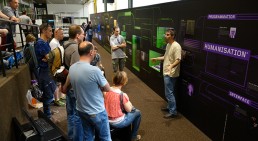
But we won’t stop there. With Programmed Disappearance, the current exhibition, we wanted to talk to everyone, young and old, and show the importance of computers in society. In this continuity, the new museum will build on the collection (one of the richest in Europe) to tell the past, present and future of digital technology, and explain how the computer has profoundly transformed, for better or worse, all aspects of our daily lives. The team of Musée Bolo is fortunate to be able to count on the support of Marc Atallah, director of Maison d’Ailleurs, who has developed an innovative museographic concept for us.
EPFL, the museum’s historical partner, is part of the adventure, and François Marthaler, former State Councillor of the Canton of Vaud, provides immense support at the political level and for the follow-up of the project.
We are aware that many steps still need to be taken, but the ideas are good, the foundations (collection, current museum, activities of the association) are solid and the partners are enthusiastic.
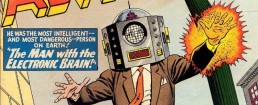
The beginnings
Enough about the future of the museum, it’s time to tell you its story. It began in 1995 with an Apple II found on the street, ready to be scrapped, while I was a computer science student at the EPFL. Surprisingly, I remember perfectly the place and the fact that, once the machine was plugged in, I immediately started programming a set of Mandelbrot in Basic. The collection grew slowly at first, it wasn’t my priority. But, as my interest in the history of computer science became clearer, as I discovered all the richness of this extraordinary evolution, the collection quickly grew and became my main hobby, the project of a lifetime.
When I talk about this period with my wife, she likes to remind me that I had nine old computers when I met her in 1996. So she has lived through all the stages of Musée Bolo, the good times and the bad times, and she is always by my side. What courage!
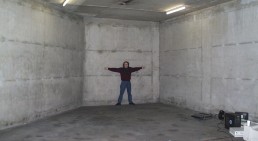
The encounter with Professor Jean-Daniel Nicoud, also in 1996, was decisive. Having attended school in Geneva during the 1980s, I had never heard of the Smaky computers. Professor Nicoud told me their story and gave me a dozen computers, doubling the size of my collection. I had to find a solution for storage. The first exhibition was set up in an unused room of my parents’ house, in Collex-Bossy, and I was also able to take part in a first event around BBS. I remember that the mayor of the village had visited my first “museum” and I was very proud of it.
The life of a collection
From that point on, it’s a blast. At the beginning of 1999, I decided to rent a 100 m2 storage room to house the collection. It seemed huge to me; it only took two years for it to overflow. At the call of Robin Chytil, a collaborator at Silicon Graphics, and with the help of the brand new aBCM association “Les Amis du Musée Bolo”, I was lucky enough to be able to save a large amount of computers of the prestigious brand when the European production centre in Cortaillod closed down. This is the final blow, more space is needed. My employer at the time, ELCA Informatique SA, generously offered to provide me with a new, larger space on Avenue Ruchonnet in Lausanne.
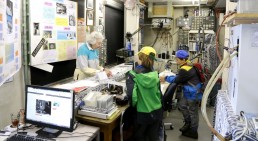
The hunt for historical computers is on, sometimes in unlikely places. The highest of these is the scientific research station on the Jungfraujoch at 3,450 metres above sea level. These were two Belgian scientists, Ginette Roland and Luc Delbouille, who opened the doors of this wonderful place where, since the 1950s, computers have been used to study solar radiation. The repatriation of a few tons of material by train, across the mountain, was a memorable adventure. This contact also took us to Liège, where we saved the oldest complete computer in the museum, a Hewlett-Packard 2116 from 1966. As with other trips to Europe to bring back large collections, crossing the border was a bit stressful.
Some donors know the value of what they are offering, others do not. I remember an employee of the University Hospitals of Geneva who called me one day and told me without much conviction about a blue computer. My blood only goes around, and two hours later the museum has its first IMSAI 8080, a rare and emblematic micro-computer from 1975. On the other hand, I spent a whole day in Lyon with the owner of the city’s first computer shop, which opened in the 1970s. He was really looking to preserve its history and was happy to find an institution capable of doing so.
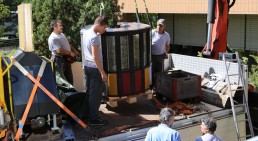
The schools in the region also have a heritage to save. EPFL, of course: the school has seen many supercomputers and it was within its walls that the Smaky was developed (the micro-computing laboratory, LAMI, was located one floor above the premises now occupied by Musée Bolo). The move of the Cray 2, weighing two tons, was a great moment. Many historical objects were recovered at the HEIG-VD in Yverdon and our extraordinary Connection Machine comes from the University of Geneva.
The meetings
A collection is not only items, obviously, but also encounters. The first important encounters led to the creation, in 2001, of the Association “Les Amis du Musée Bolo”. One of the members of the first committee, Edouard Forler, worked with me to set up the first permanent exhibition at the EPFL. On the initiative of Professor Roger Hersch, who thought it was a shame to have unused space next to his laboratory, we presented the project to the people in charge of the Faculty of Computer Science and Communications, who seemed to be absorbed by something else… It was September 11, 2001. The first Musée Bolo was inaugurated with great fanfare on June 19, 2002.
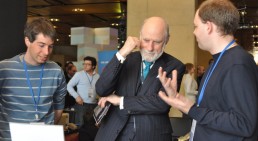
In 2009, we were invited by Laurent Haug to present some of our machines at the Lift conference in Geneva. An event particularly rich in encounters, since we were able to introduce the Smaky to the “father” of the Internet, Vinton Cerf, and it was there that we met Bruno Bonnell, founder of Infogrames, for the first time. Later, this pioneer of the French video game industry gave us his fantastic collection of video games, now studied in particular by the UNIL GameLab.
For the 20th anniversary of the Web, we had a contact with its co-inventor Robert Cailliau, who needed a special adapter to connect Tim Berners Lee‘s historic NeXT Cube to a video projector. The aBCM Association rose to the challenge with flying colours, and was even commissioned by CERN to save the data on the machine’s hard disk. We were also lucky enough to meet other pioneers such as Charles Blanc, who bought his first computer for EPUL (former name of the EPFL) in 1956, Peter Toth, designer of the first commercially available Swiss computer, and Niklaus Wirth, inventor of the Pascal programming language, who befriended us to become a founding member of the Mémoires Informatiques foundation.
In 2004, I met the first journalist specialized in computing in Switzerland, Marielle Stamm. From then on and for almost 15 years, she worked hard to help Musée Bolo move forward: she was instrumental in setting up the exhibition Programmed Disappearance and co-authored with me the eponymous book.
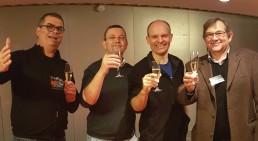
Entre passionnés, on se comprend. Les contacts entre collectionneurs ont été multiples et ce dès le début de la collection. D’abord du côté francophone (Philippe Dubois et MO5.COM, le Club 8-bit, le forum Silicium), puis un peu partout dans le monde et plus récemment avec tous les collectionneurs suisses. Ma rencontre avec Svetozar Nilović, directeur du très dynamique musée Peek&Poke à Rijeka, en Croatie, m’a permis de découvrir un pays que je ne connaissais pas, ainsi que l’histoire complexe de la micro-informatique en ex-Yougoslavie.
The team
The Association aBCM “Les Amis du Musée Bolo” was born in 2001 and has since been always very active. But lately it is the effervescence. Events, various and varied projects, storage and recovery of material for the collection: the team, mostly from the generation born in the 1980’s and who regularly welcomes new members, has no time to get bored. It meets at least once a week, on Tuesday evenings, but also more and more often during the day and at weekends.
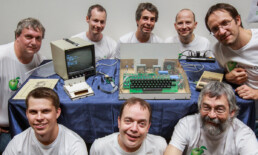
In 2014, when the originals of the first Apple computer were sold at auction for several hundred thousand dollars, the association set out to create a replica. The Pomme One project had started, a project that not only consists of making the copy, but also of many ancillary elements such as a keyboard mounted key by key and a transparent plexiglass case. The team often repairs machines for demonstrations of old equipment in operation: recently, the Sega Fish Life from the Bruno Bonnell Fund, a rare virtual aquarium from the year 2000, was reactivated. Even more impressive is the reactivation of the Blue Gene/P, supercomputer, which consumes 25 kW, used at the EPFL until 2013 and donated to the museum by IBM.
In contact with Logitech and its founder Daniel Borel for several years, we were fortunate enough to host a temporary exhibition in 2016 and 2017 to celebrate the 35th anniversary of the Swiss company. The association also collaborates with companies or individuals to recover data from obsolete media, a service that could become a source of income for the future museum. In addition, we regularly receive requests from artists for photos, exhibitions or film projects. One band even used a 1986 Macintosh Plus, configured by us, during a concert.
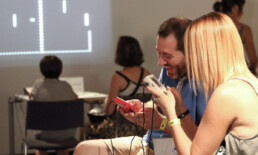
But the most visible activity of the aBCM association is the organization of events. Historically, it is the Night of the Museums of Lausanne and Pully, at the end of September, which is the flagship event of Musée Bolo. During our first participation, in 2004, we were invited to the “after party” in the LEB station in Lausanne: a great moment, when we finished at 4 AM, a little stressed for the equipment at the sight of the last staggering party-goers wishing to play a last game of Pong, beer in hand. We have collaborated several times with the Museum of Communication in Bern and, since 2014, we are participating in the Numerik Games festival in Yverdon, invited by Maison d’Ailleurs. We also regularly lend objects to other museums (Historical Museum of Lausanne, Museum of the Hand, Museum of Communication).
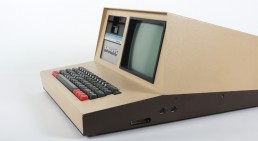
Musée Bolo tomorrow
How far we’ve come. It’s quite crazy to imagine myself in 1995, in my student apartment with a dozen computers around me. It’s real teamwork. I would like to thank all our partners, donors, volunteers and the association aBCM “Les Amis du Musée Bolo” for the many projects already realized.
And I am looking forward to building with them a modern, public and interactive museum that will enhance the collections to tell the story of the adventure of the digital society.
Would you like to help us?
Thank you! Any form of support is welcome.
From Yves Bolognini
